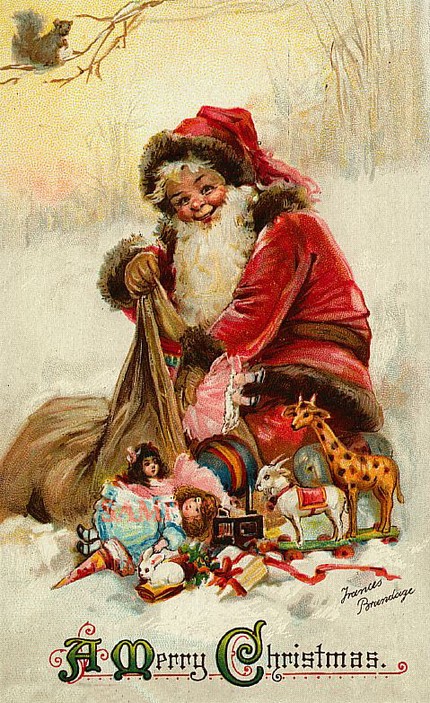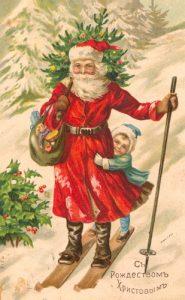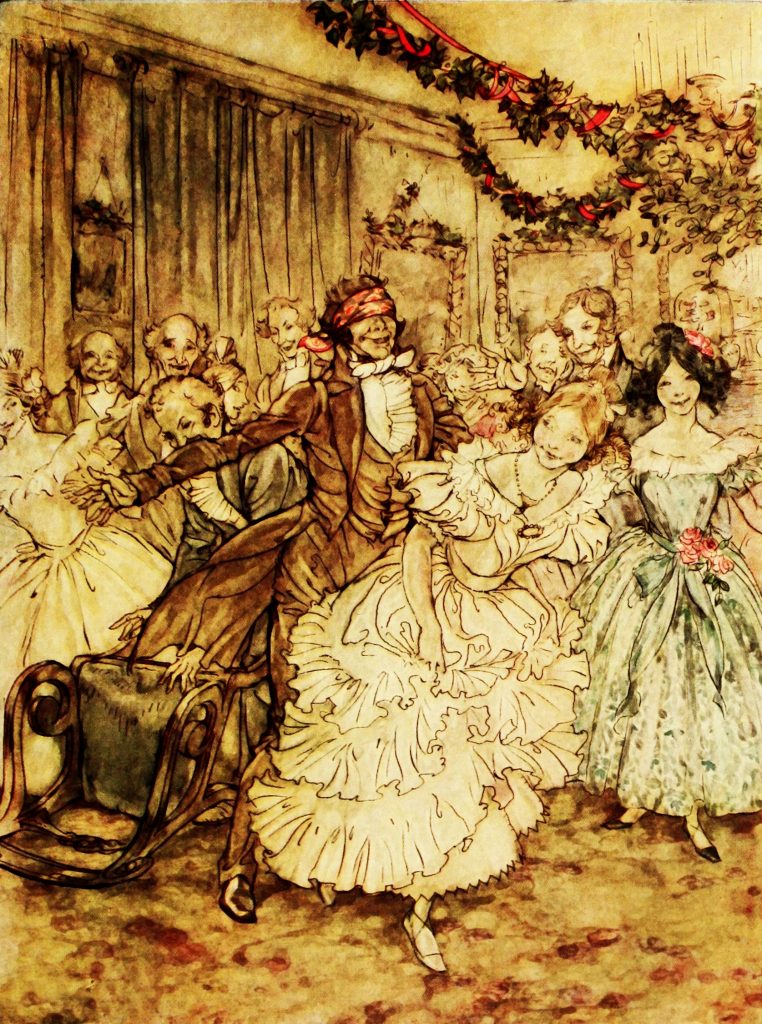Some time ago I began to understand and appreciate the impact that Victorian culture has had on certain holiday traditions.
 The Victorians instilled an idea of familial happiness that was created through playing of quaint games and creating traditions that could be enjoyed in the middle and upper classes. These turned out to be so successful that people in our own age continue these practices. In fact, we may have quite a few Christmas traditions that we can thank the Victorians for, such as the singing of Christmas carols (or the revival thereof), the giving of gifts, evergreen decorating, St. Nicholas (in popular culture), and the giving of Christmas cards. In Britain in 1840, postcards were put up for sale for a penny, which made it easier for the tradition of Christmas card sending to be born. In 1876 the price of a stamp was decreased to a half-penny. In the United States, Louis Prang became known as the “Father of the American Christmas Card”, selling five million of them annually by 1881.
The Victorians instilled an idea of familial happiness that was created through playing of quaint games and creating traditions that could be enjoyed in the middle and upper classes. These turned out to be so successful that people in our own age continue these practices. In fact, we may have quite a few Christmas traditions that we can thank the Victorians for, such as the singing of Christmas carols (or the revival thereof), the giving of gifts, evergreen decorating, St. Nicholas (in popular culture), and the giving of Christmas cards. In Britain in 1840, postcards were put up for sale for a penny, which made it easier for the tradition of Christmas card sending to be born. In 1876 the price of a stamp was decreased to a half-penny. In the United States, Louis Prang became known as the “Father of the American Christmas Card”, selling five million of them annually by 1881.
One of the most important figures in the Victorian revival of Christmas was Charles Dickens. Prior to Dickens’ time, Christmas had become identified with alcoholic excess and led to the prohibition of the holiday by Puritans when they arrived on the shores of America. The ban on Christmas continued well into the nineteenth century; the London Times did not even mention the holiday from 1790 to 1835 – forty five years without a Christmas mention!
The lukewarmness over the holiday during this time can be witnessed in what the Manchester Courier wrote in December of 1828. Perhaps trying to kindle the fire of interest in Christmas after the publication of Christmas poems, it commented:
We hope that our author’s spirited attempt to revive the dormant enthusiasm with which our forefathers celebrated these ancient customs and festivals, which were older still than they, will not be altogether unsuccessful. Mr Moxon’s publication would make a very suitable Christmas gift.
 A Christmas Revival
A Christmas Revival
The turning away of Christmas that marked this Georgian era (pre-Victorian) would not last forever, though, and one of the catalysts for change was the publication of Dickens’ A Christmas Carol in 1843. Fifteen thousand copies were sold, and for the next several years he released new seasonal stories on an annual basis until 1848. He made an effort to get his colleagues to join in this literary effort of celebrating Christmas, and the revival of Christmastime as a distinct season of the year was underway. Dickens certainly must have tapped a vein in the English heart that desired this new sense of Christmas, for others soon joined in trying to capture the Christmas Spirit. In 1846, Punch wrote, “The Literature of England promises, or rather threatens, to be inundated this year with a flood of Christmas Books. Every little author is preparing a five-shilling volume in imitation of the Christmas Carol.”
Another Christmas tradition that goes back to the Victorians is the Christmas tree. Although it traces its origins back to Germany, it was not until after its arrival in Windsor Castle in 1841 that it became popularized in England. Queen Victoria wrote about her children who were “full of happy wonder at the German Christmas tree,” and in 1851, Dickens mentioned “that pretty Germany toy, a Christmas tree,” both references of which suggest the relative newness of this cherished ornament to England. In 1848, a picture of the royal couple, celebrating Christmas with their children by the Christmas tree, was published in Britain and the United States. A new cultural tradition was born.
So we do owe a lot of credit to the Victorians for helping establish Christmas as we know it today. How many of us regularly participate in those traditions that were established during that long reign of Queen Victoria without even knowing where they came from?
What’s in a sugar plum, anyway?
 And lastly, on a related note, a well-known food from the Victorian era is the sugarplum, which regularly makes a reappearance in our Christmastime consciousness when we hear Tchaikovsky’s Nut Cracker Suite. Have you ever wondered what a sugarplum is? It’s really quite simple: a mixture of chopped figs, apricots, nut meats, and dates, along with some brandy and powdered sugar. Then, they are rolled into balls and coated with more powdered sugar.
And lastly, on a related note, a well-known food from the Victorian era is the sugarplum, which regularly makes a reappearance in our Christmastime consciousness when we hear Tchaikovsky’s Nut Cracker Suite. Have you ever wondered what a sugarplum is? It’s really quite simple: a mixture of chopped figs, apricots, nut meats, and dates, along with some brandy and powdered sugar. Then, they are rolled into balls and coated with more powdered sugar.
Visions of sugarplums danced in their heads. Visions of sugarplums danced in their heads.
Note – sources for information in this article have been included where possible, but some of the sources have been lost and are not included.
 A Christmas Revival
A Christmas Revival

